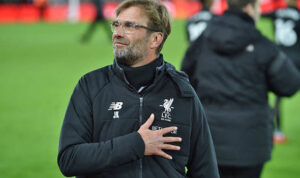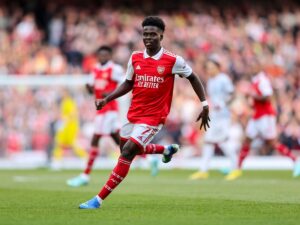The Future of Arsenal: Martin Ødegaard
A degree of natural technical ability preceded only by his own reputation, Arsenal’s Martin Ødegaard presents a unique and interesting focus for analysis. This Total Player Report will examine and break down in detail the player Ødegaard is and what he offers.
Martin Ødegaard has been in the public eye since adolescence. In 2014, the player was linked to a number of top European clubs after featuring 23 times for Strømsgodset in Norway’s premier division at just 15 years old (scoring five and assisting six). He became Norway’s youngest ever full international during that same year.
Eventually moving to Real Madrid in a lucrative deal at 16 years old, Ødegaard then found himself either back with youth teams he had already outgrown or playing for one of four clubs in three countries after a series of loan moves.
Everywhere Ødegaard went, he impressed. Except, apparently, at parent club Real Madrid.
His final loan move – to Arsenal in the Premier League – eventually culminated in Real making a permanent deal with the North London club.
Positional game
Martin Ødegaard can be simplistically placed as an attacking midfielder. A 10. Strong with both feet but natural with his left, Ødegaard most often plays in the central attacking midfield position and drifts right to cut onto that stronger side.
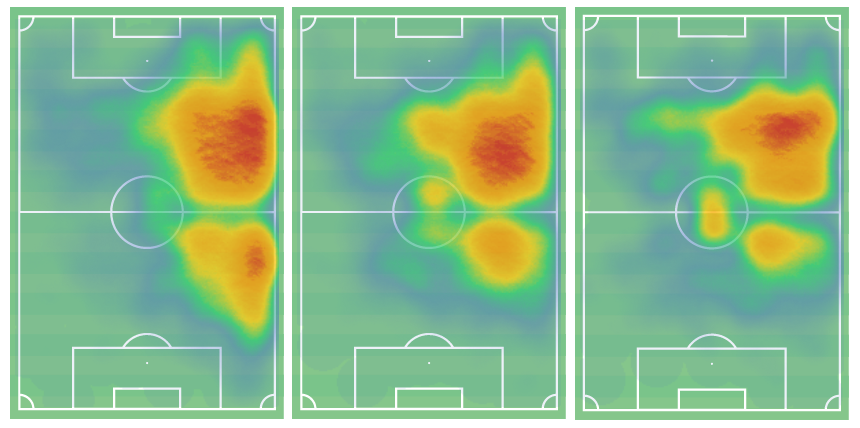
This analysis will focus heavily on Ødegaard as a creative force, and most of that creativity comes through an advanced attacking platform, but this player is multi-faceted. He can operate in deeper positions, utilising elite passing range to advance the ball quickly and accurately; he can operate in wider positions, taking advantage of advanced pockets of space wide of defensive lines where he can find a cutting through pass – as he regularly does for the Norwegian national team.
Where he plays most often – where he currently plays – is in that advanced central channel, linking the midfield with attack, acting as a pivotal playmaker with runners on either side.
From here Ødegaard is able to receive the ball in advanced areas, able to play on the half turn and find runners with his short passing. He is able to set the tempo and control the play during spells of possession. He is able to impress himself on the game in a position that suits his creative strengths.
Off the ball – an aspect we will come to later – playing through this involved central channel allows Ødegaard to engage and often even lead an active and aggressive mid-high press.
Capable as an 8 in a compact, tight midfield, or as a more disciplined and defensively focused deep-lying playmaker, Ødegaard is much more in his element when playing into or through the opposition final third. He is a strong midfielder but a natural attacker.
Passing, vision, the creation of chances
For this analysis, one that is keenly focused on the concept of creation and creativity, this seems like the logical place to begin.
This is his area of expertise. Ødegaard is very comfortable playing intricate football in key offensive situations.
A main standout aspect in this, one that defines his creative passing, is his control of his strides and his sense of timing when executing the through ball.
Ødegaard likes to take short, sharp touches of the ball, maintaining close control with his head up and scanning for the opening. The short touches allow the pass to be played at the right moment.
It is a considered, composed style of carrying the ball through the attacking midfield areas. Ødegaard is always looking for the pass and always prepared to play it.
Martin Ødegaard is a thoughtful playmaker, he takes his time to see the pass and won’t release the ball until he knows the time is right, but he isn’t hesitant.
I’ve tried to separate his low through passes from higher, longer ones, and this has the benefit of demonstrating that Ødegaard is happy to take one touch to set himself before firing the incisive long ball. As long as the moment is right and the pass is right.
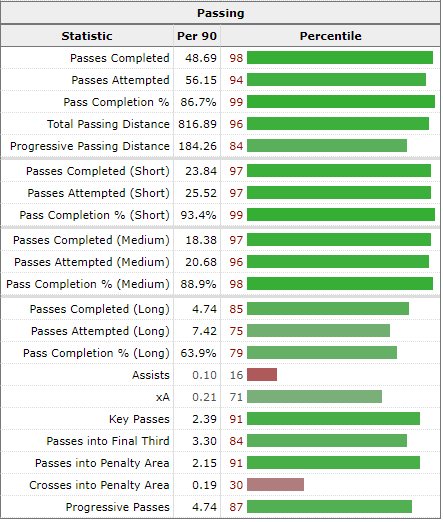
His passing is confident, decisive, and usually accurate. Statistically, Martin Ødegaard genuinely excels. He has been in the top bracket in key relevant creative metrics since joining Arsenal.
He is among the most effective and consistent playmakers in European football. The finish rarely matches the assist, but that does not subtract from it.
His long passes, through passes, passes to the final third, passes to the opposition penalty area are all at best deadly accurate and at worst perfectly solid.
He is currently Arsenal’s leading creator and finds himself centrally involved in most of his team’s dangerous moments.
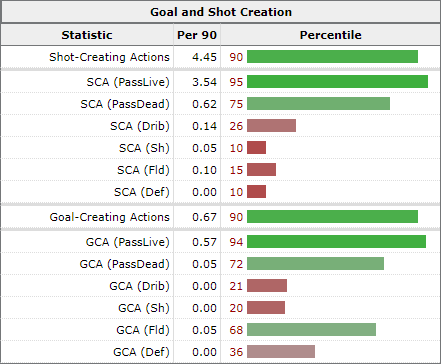
Through passing and dead balls – more on this in a moment – Martin Ødegaard is able to regularly contribute to or directly create goal-scoring chances.
Not just a great technical creator, but also a consistent and effective one. Ødegaard knows his strengths, expresses them, and uses them to great effect.
Set pieces
Alongside that technical ability, perhaps another symptom of it, is Ødegaard’s aptitude to deliver high-quality balls from dead-ball situations. There are a number of effective direct efforts at goal, a few we will see a little later, but the focus here remains on creation and assisting.
Ødegaard is a regular on both corner kicks:
and free-kick duty:
His open play crossing itself isn’t spectacular, far less so than his short passing and through balls, and this is likely owing more to his style and preference of the central channel than any real limitation. But when he takes a corner or free kick from a wide angle, and the cross is his best option, the execution is often sound.
Ødegaard can play the ball into an area wide or high of defenders, he is able to find the head of his near or far post runner. He can do it, but it isn’t something we see from him very often in open play.
Shooting and scoring goals
Martin Ødegaard isn’t a high-volume goal scorer, he isn’t that kind of 10. His game is, as we’ve seen, far more focused on the creative side. He drops back into space in order to receive the ball with the view to releasing a runner, he doesn’t tend to advance and run off the shoulder of his defensive line. Even so, Ødegaard has scored 0.19 goals per 90 over his club career. This translates to 25 goals in 164 appearances.
There have been a number of direct free kicks scored, we’ve seen how well he takes a set piece and this extends naturally to the direct ones. He prefers a low arc, powerful and curling. It’s effective and impressive. But that isn’t the main focus for me.
Martin Ødegaard shows great ability in clean, well-timed, and ultimately accurate striking of the ball. The same technique he uses for passing – the short strides, the close control, the patience in waiting for the right moment – is seen also in his shooting. The connection is clean and the technique is textbook, as it is with his passing, he just decides on a different avenue.
He prefers to either drop off into space outside of the box or offer a supporting cut-back option. Ødegaard doesn’t usually run ahead of the ball, he doesn’t have those attacking instincts. When he receives the ball in an attacking area he usually has defenders ahead of him and a line to break.
Ødegaard averages just over 1 shot per 90 over his senior club appearances in top European leagues, shooting isn’t a preference, but he can do it and when he does he usually does it well. That level of technical ability, the control Ødegaard has over the ball and the clinical precision he shows in his technique translate well to shooting.
Defending, aggression, leading the press
A leading aspect of Arsenal’s game under head coach Mikel Arteta is an active and aggressive high press. With energetic and exuberant young attacking players – the likes of Bukayo Saka, Emile Smith Rowe, Gabriel Martinelli and Folarin Balogun – Arsenal’s high pressing has improved greatly. Martin Ødegaard fits neatly within this.
When Arsenal are out of possession Martin Ødegaard is no longer the technician, the classy number 10; he is now a driven and motivated front foot defender. He shows great desire to close space and confront his attacker, he often leads the 3 or 4 man high press and advances his team’s position.
Ødegaard isn’t a player to relax when his team doesn’t have the ball, if anything he becomes more active. He seems to sprint more and covers more ground quicker when he’s defending. He is slower and methodical on the ball, considered and thoughtful; out of possession, he can be proactive and aggressive. There is a real determination in Ødegaard that manifests itself in an active, fast, effective attacking press.
He has been among Arsenal’s most active and effective pressing players, especially in the middle and final thirds. The examples I took are from Arsenal’s most recent games, you can find 20-25 of these active pressures in any of Ødegaard’s games for Arsenal. What is less common, perhaps expectedly so for a player of his profile, are active ball-winning defensive actions.
To find these I had to be far more specific. He isn’t a ball-winning midfielder, his defensive technique is fine, his timing of the challenge is good and he shows great determination and energy to cover the ground, but this isn’t Ødegaard’s game.
The real activity in Ødegaard’s defensive game is in his place within the attacking pressing unit, it is about the collective rather than the individual. He can defend, he does so quite well, but he isn’t a defender.
We might see these quantifiable, active, ball-winning actions more often – from Ødegaard or his fellow attackers – once that pressing unit is more versed and adept in its work. Once those young forwards, Martin Ødegaard included, better understand the coordination and synchronicity required in an effective attacking press, we may see more showcase defending.
It shouldn’t really matter at this stage, the intention is enough if we’re focusing on only one part of a collective unit. For this side of his game, there is the promise of potential rather than defined and tangible quality.
Martin Ødegaard
It is very rare for a player to be so confident and assured in his game before his 16th birthday, especially when his opponents are fully-fledged, senior professionals. Even rarer perhaps for a player that young to be thrust into the public eye. This naturally leads to a lot of unrealistic expectations and unfair scrutiny.
Martin Ødegaard signed for one of the world’s biggest clubs on a lucrative, hugely publicised contract at just 16 years old. This led to stunting in his development. Instead of finding himself within a group, where he could develop in a healthy environment, Ødegaard was loaned repeatedly.
Heerenveen, Vitesse, Real Sociedad, Arsenal; including first club Strømsgodset, Ødegaard played in six different teams in his first six years as a professional. It isn’t natural and it isn’t helpful. It certainly isn’t conducive to proper youth player development. And despite his level of talent and natural ability, Martin Ødegaard was a youth player.
Finally, six years after joining Real Madrid, Martin Ødegaard has a settled and healthy environment. He used those six years as well as he could, he showcased his ability and nurtured his understanding of the game. He tried to find his place within European football. But he never truly settled. Settlement is key to sustained consistent high performance.
There is an irony that Arsenal – a club that has suffered from a certain disheveled loss of identity – will offer that long-term sanctuary for Ødegaard. A famous club full of potential which desperately needs to feel settled with a famous player full of potential who needs the same. A match made in heaven, you would think.
